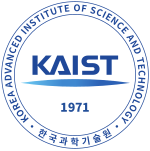Korea Advanced Institute of Science and Technology
| 한국과학기술원 | |
 |
|
| Type | Public |
|---|---|
| Established | 1971 |
| President | Shin, Sung-chul |
|
Academic staff
|
1,140 (2013) |
|
Administrative staff
|
322 (2008) |
| Students | 10,249 (2013) |
| Undergraduates | 4,047 (2013) |
| Postgraduates | 6,202 (2013) |
| 2,311 (2013) | |
|
Other students
|
1,187 co-terminal MS/PhD (2013) |
| Location | Yuseong, Daejeon, South Korea |
| Campus |
Urban 1,432,882 square metres (354.07 acres) (Daedeok Campus) 413,346 square metres (102.14 acres) (Seoul Campus) |
| Affiliations | AEARU, LAOTSE, AOTULE, ASPIRE League. |
| Website | kaist |
 |
|
| KAIST | |
| Hangul | |
|---|---|
| Hanja | / 카이스트 |
| Revised Romanization | Hanguk Gwahak Gisurwon / Kaiseuteu |
| McCune–Reischauer | Han'guk Kwahak Kisurwŏn / Kaisŭt'ŭ |
| University rankings | |
|---|---|
| Global | |
| ARWU | 201-300 |
| Times | 148 |
| QS | 46 |
| Asia | |
| ARWU | 24-35 |
| Times | 10 |
| QS | 4-6 |
KAIST (formally the Korea Advanced Institute of Science and Technology) is a public research university located in Daedeok Innopolis, Daejeon, South Korea. KAIST was established by the Korean government with the help of American policymakers in 1971 as the nation's first research oriented science and engineering institution. KAIST also has been internationally accredited in business education. KAIST has approximately 10,200 full-time students and 1,140 faculty researchers and had a total budget of US$765 million in 2013, of which US$459 million was from research contracts. From 1980 to 2008, the institute was known as the Korea Advanced Institute of Science and Technology. In 2008, the name was shortened to KAIST.
In 2007 KAIST adopted dual degree programs with leading world universities to offer its students diverse educational opportunities and strengthen academic exchanges; since then with the Technical University of Denmark,Carnegie Mellon University, the Georgia Institute of Technology,Technische Universität Berlin, and the Technische Universität München.
The institute was founded in 1971 as the Korea Advanced Institute of Science (KAIS) by a loan of US$6 million (US$34 million 2014) from the United States Agency for International Development (USAID) and supported by President Park Chung-Hee. The institute's academic scheme was mainly designed by Frederick E. Terman, vice president of Stanford University, and Chung Geum-mo, a professor at the Polytechnic Institution of Brooklyn. The institute's two main functions were to train advanced scientists and engineers and develop a structure of graduate education in the country. Research studies began by 1973 and undergraduates studied for bachelor's degrees by 1984.
...
Wikipedia
